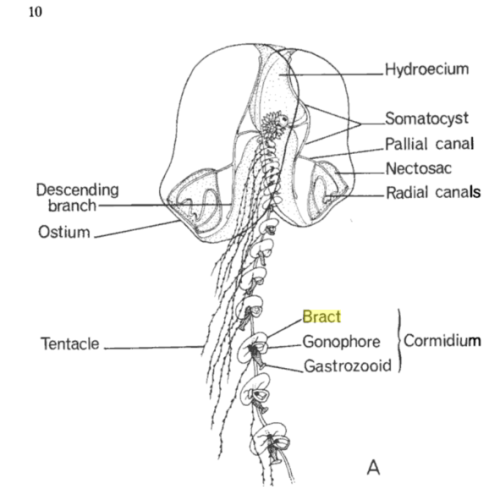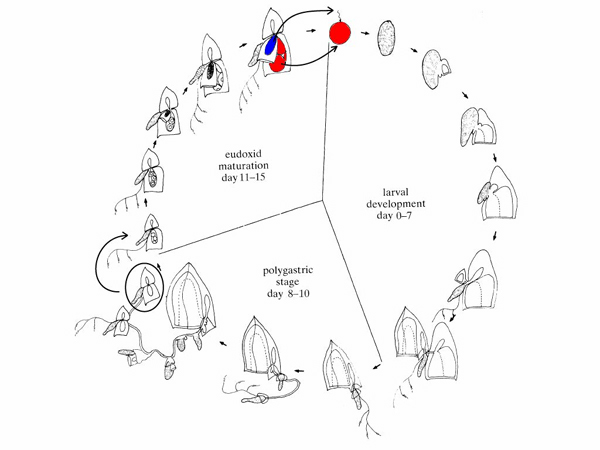SIPHONOPHORES - differences, anatomy, life cycle
-
 by
yshish
moderator, translator
by
yshish
moderator, translator
Siphonophores
Here is my summary of various Siphonophore types you will meet on Plankton Portal. I hope it will help you to tell them apart.
If you prefer some image examples, go here: CLICK.
 
Siphonophores are an order of the Hydrozoa, a class of marine animals belonging to the phylum Cnidaria. Siphonophore appears to be a single organism, each specimen is actually a colony composed of highly specialized individual animals, called zooids.
There are three Suborders of Siphonophora — Physonectae (Corncobs), Cystonectae (Pacific man o' war), and Calcophora (Rocket-ships and Twocups) — distinguished from each other by the presence and absence of three main body parts: the pneumatophore, the nectosome, and the syphosome.
I. "CORNCOBS" Physonect siphonophores have all three parts, pneumatophore, syphosome and nectosome.
II. "MAN O' WAR" Cystonect siphonophores have a pneumatophore and syphosome, but no nectosome. (You probably won't see any on Plankton Portal.)
III. "ROCKET-SHIPS" and "TWOCUPS" Calcophoran siphonophores have a nectosome and syphosome, but no pneumatophore.
A schematic comparison of the three types of siphonophores

1. "CORNCOB" category
- Anatomy: Physonect siphonophores have all three major body parts. You'll recognize them by the opaque nose-like structure, called pneumatophore.
- Pneumatophore
At the top of a siphonophore colony is the gas-filled float (an opaque nose-like structure you find in Corncobs). The pneumatophore is a two-walled structure containing gas secreted by a "gas gland" or pneumadenia. The pneumatophore functions as a float that helps siphonophores remain at the proper level in the ocean.
- Nectosome
Below the pneumatophore is the nectosome, made up of asexual medusoid zooids called nectophores or swimming bells. These nectophores are responsible for swimming. New nectophores bud from just below the pneumatophore, so that the oldest nectophores are at the the bottom of the nectosome.
- Siphosome
The lowest body section, made up of several kinds of polypoid zooids as well as sexual medusoids. Here you would find the feeding polyps, or gastrozooids, each of which has a single tentacle it uses to catch prey (Mackie, et al. 1987, Dunn Siphonophores). There are also palpons, polyps whose function is not entirely clear, but may play a role in defense and excretion. Bracts are heavily modified zooids of indeterminate (medusoid or polypoid) origin, that can grow large enough for the other zooids to hide behind them when startled (Dunn Siphonophores).
2. Twocups category
- Anatomy: Both Twocups and Rocket-ships belong under Calcophoran siphonophores, and both have a nectosome and syphosome part, but no pneumatophore (the opaque nose-like structure). They've got paired swimming bells, they remind of two hoods/cups or two halves of a coconuts, and a single branching tail that usually appears thick.

3. Rocket-ship category
- Anatomy: Both Rocket-ships and Twocups belong under Calcophoran siphonophores, and both have a nectosome and syphosome part, but no pneumatophore (the opaque nose-like structure). Rocket-ships have usually a single swimming bell but as you can see in their life cycle graphic, there are life stages with multiple swimming bells. Depends on the species, the swimming bell can be pointy (triangle/rocket-like) or round (thimble-like), and a usually a single branching tail (missing in some live stages).

- Life cycle of Rocket-ships

Hope there are no wrong information. Please, correct me if you find something wrong or misleading. Thanks!
Source:
-
https://sites.google.com/site/rangellsiphonophore/home/anatomy-and-development
-
http://www.gbri.org.au/SpeciesList/Diphyessp%7CAliciaWhillier.aspx?aid=164&PageContentID=4554
Posted